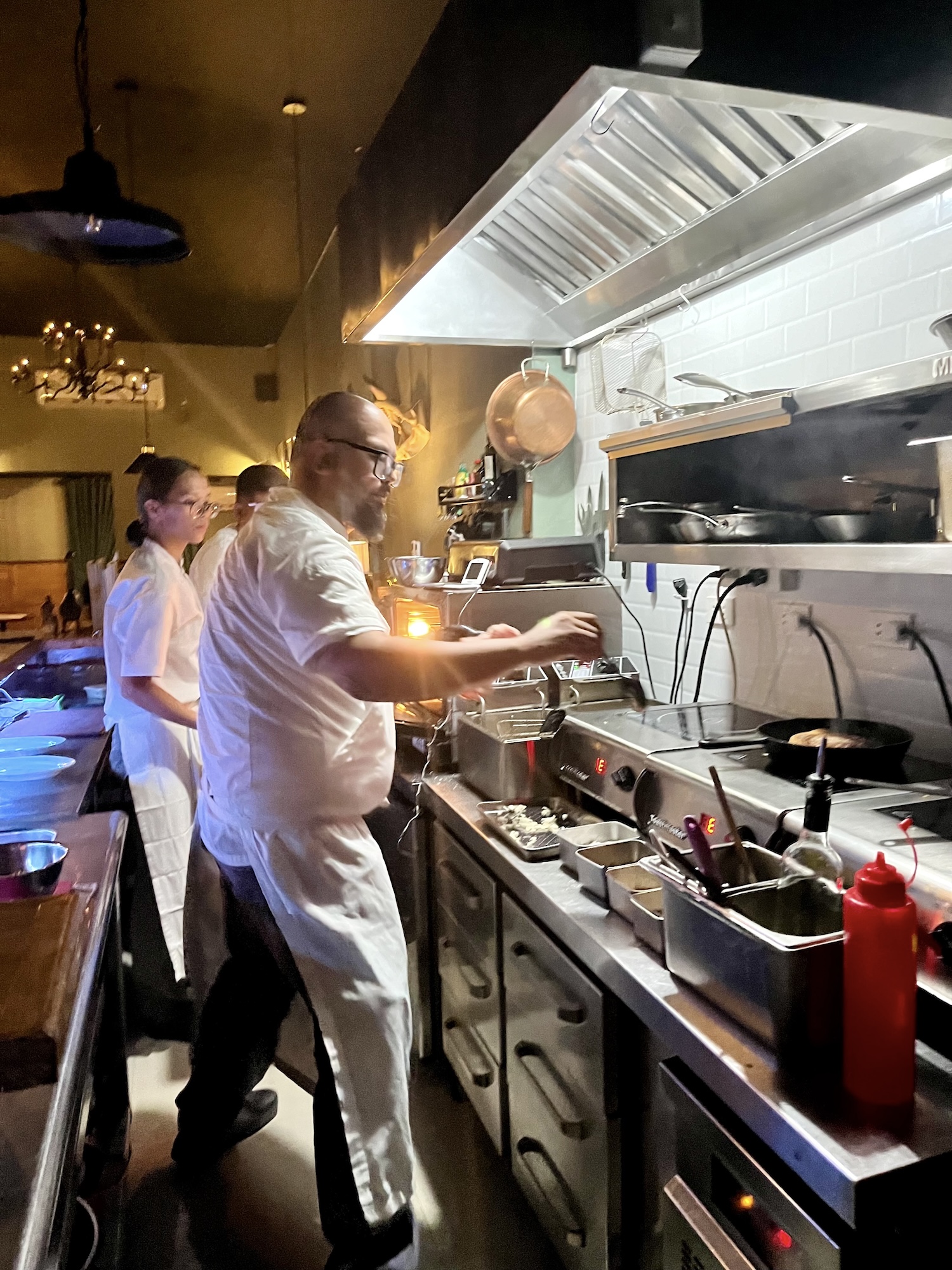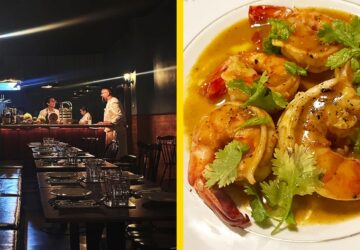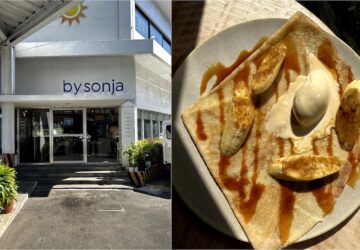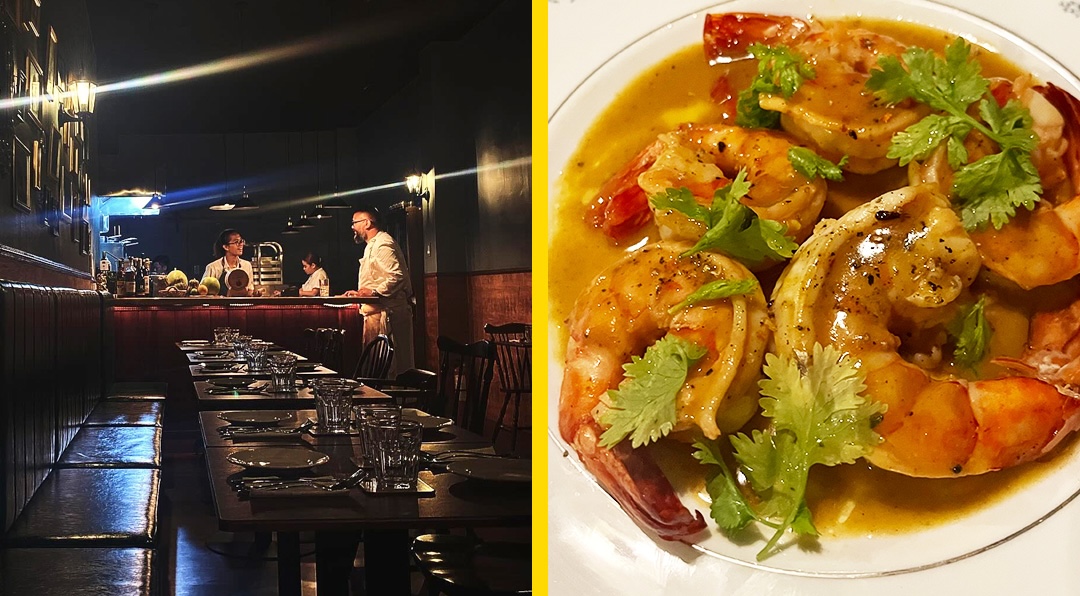Amid the supersized establishments and neon-lit Korean concepts along the bustling Fil-Am Friendship Highway in Angeles City, Pampanga, it can be nearly easy to miss Tito Boy, the intimate 22-seater bistro by chef Bong Sagmit.
Step into its cozy space and the difference among its neighbors is even starker: the lights are dimmer, the footprint smaller, its interiors hearkening to more classic tavern-like interiors. Its walls are awash in sage and wood paneling, decked out in a gallery of bird illustrations and lead to an open kitchen, where Sagmit leads a team of three in dishing out entrées and appetizers.
Opened in February this year, Tito Boy has quickly earned acclaim among a growing clientele of discerning diners in Pampanga who usually make up the restaurant’s dinner crowds. That is thanks in large to Sagmit’s culinary reputation in his home province: He was at the helm of Pigs & Pints and BBQ & Co, which introduced refined approaches to gastropub concepts in Clark. He also held a 12-year stint at the Century Hotel in Angeles as its executive chef before joining fellow Kapampangan chef Sau del Rosario in Makati where he headed the kitchen at Sawsaw’s first location along Kalayaan Avenue.
The making of Tito Boy

With Tito Boy, Sagmit has come home, literally and figuratively. “Nicole Ponseca (of New York City’s Jeepney) said it very well that for every Filipino family, there is a Tito Boy,” he quips. In Sagmit’s case, Tito Boy is his father.
A few choice elements are inspired by Sagmit’s dad, but Tito Boy is largely built out of a persona that serves as a guide for Sagmit and his team. “Tito Boy is an outdoorsman—he likes to hunt and sail. He likes whisky but also drinks Pale Pilsen depending on who he’s with. He likes simple, five-ingredient dishes but has taste,” Sagmit explains.
This informs the restaurant’s interiors as well as its short, sweet, and seasonal menu that changes every few weeks. Sagmit’s dishes are deceptively simple and not beholden to a particular cuisine. Dishes like sisig croquetas and pork chop are simply named yet feature hearty portions and a refined approach to comfort food.
“Nicole Ponseca (of New York City’s Jeepney) said it very well that for every Filipino family, there is a Tito Boy,” chef Bong Sagmit quips. In his case, Tito Boy is his father.
The pork chop, in particular, is an inch-thick meat made tender from a citrus brine, served with wilted kale, horseradish, and lardons.
“At the end of the day, I want my fried chicken and burger, pork chop, done right,” he emphasizes.
The chef adds that the menu plays around with global influences while trying to source what they can locally.
“It’s globally inspired pero leaning towards Filipino ingredients… Gusto ko pa rin maging local when it comes to sources. Pero siyempre, you cannot deny yourself with butter, you cannot deny yourself with good olive oil,” Sagmit explains.
Some dishes that best represent this approach include Tito Boy’s catch of the day—for us, it was betilya or a local sea bream that Sagmit found in the market earlier that day—fried in chicken fat, garlic, and rosemary—brimming in flavor and texture.

Another was the crowd-favorite burrata salad featuring Pampanga-made burrata, which had a creamy and springy texture with persimmons and tomatoes.
For Sagmit, who was once known to play around with molecular gastronomy, it’s about creating great food with no shortcuts. He brings up one of his earlier dishes, a play on the classic pork and beans dish with pork belly confit and Cannellini beans, as another example.
“I’ve dealt with a lot of molecular fermentation, what have you. I had a concept for a restaurant that we did open fire. Pero at the end of the day, pagkatapos ng techniques, ang gusto mo lang naman talaga pork and beans eh. Ayaw ko nang masyadong i-glorify ’yung ginagawa ko,” he shares.
“It’s globally inspired pero leaning towards Filipino ingredients… Gusto ko pa rin maging local when it comes to sources. Pero siyempre, you cannot deny yourself with butter, you cannot deny yourself with good olive oil.”
That said, he’s not shying away from the techniques he’s learned in the kitchen; only that they’re not used as crutches to make dishes sound appetizing.
“We just don’t try to sell techniques. We try to sell food,” Sagmit adds. “Kung makikita mo sa menu, nakalagay slow roasted. I would put sous vide sa description niya. Pero I’m not going to emphasize that—I would tell you na malambot siya. If you ask me how [I made it tender], of course I’m going to share it. But I’m not going to try to compensate by telling you, ‘Oh, we did a poly… we have a polyscience,” he explains.
Coming home to Pampanga

While no stranger to opening concepts, Tito Boy is Sagmit’s first venture with his wife Tin who is in charge of front-of-house and administrative operations. Unlike his previous concepts, Sagmit and his wife call all the shots with no other business partners.
It also happens to be Sagmit’s first venture after his stint with del Rosario ended, and he returned to Pampanga just before Christmas last year.
Although Sagmit admits that things did not work out, he talks fondly and with gratitude about his time in Manila. “Pag nagsisimula ka, you’re always trying to train yourself to be a part of the mainstream food scene. [This was] my first chance to really have the opportunity to work with the greats there. When we were starting Sawsaw, chef Sau told me, ‘Okay, you’re gonna have the best kitchen here. You have totally good backing when it comes to finances. Don’t worry about anything. Basta promise mo lang sa akin, linisin mo lang ’yung kusina mo.’”
Tito Boy almost didn’t happen, with the chef initially eyeing a fried chicken and burger joint—for a chef of his experience, it was certainly easier to run and less costly to operate.
When Sagmit returned home to Pampanga, he fielded multiple offers to return to the hotel scene, but the call to start his own venture was always there.
While the chef wanted to reel from the heartbreak of his last stint, the opportunities to begin his own concept would pop up.
“I was just laying around, resting, sabi ko, ‘Okay, stop muna. Huwag munang isipin ’yung pagkain.’ Tapos my sister coincidentally messaged me: ‘Kuya, merong mga places dito for rent. Mukhang hindi mahal.’ Tapos kaibigan ko pa pala ’yung landlord. Pinuntahan ko, nagtanong na kami,” he says of their 45-square-meter location, a former vape shop, along Friendship Highway.
It dawned on Sagmit that it was probably time for him to open his own business, save for the fact that he had a modest budget to work with.
View this post on Instagram
“Hindi naman marami ang pera ko, and I never really asked anybody for money. I had only, like, less than P2 million under my name. Tapos, siyempre wala naman P2 million na restaurant. So [I] had to be smart about it,” he says.
In fact, Tito Boy almost didn’t happen, with the chef initially eyeing a fried chicken and burger joint—for a chef of his experience, it was certainly easier to run and less costly to operate.
Sagmit credits his close friend, the Pampanga-based Italian chef Dan Giampaolo, for knocking sense into him.
“He told me, ‘What the f**k are you going to do, Bong? Are you telling me you’re gonna sell fried chicken and burgers? What happened to the Bong I know?’”
As it turned out, other people were also glued to the chef’s next moves—the moment Sagmit posted a teaser of his upcoming restaurant, he immediately received a reservation for February.
“Hindi naman marami ang pera ko, and I never really asked anybody for money. I had only, like, less than P2 million under my name. Tapos, siyempre wala naman P2 million na restaurant. So [I] had to be smart about it.”
So the chef embarked on what he jokes as a “record-breaking” feat of building and opening a restaurant in just two weeks.
Sagmit shared that 90 percent of the furniture and fixtures inside the restaurant were from surplus stores or secondhand gear from restaurants that have closed down. Others were sourced from Facebook Marketplace, Shopee, Lazada as well as a Nueva Ecija-based supplier that gave him competitive deals on equipment and other materials.
He also enlisted the help of his cousin, a contractor, to construct Tito Boy within the tight time frame.
It was a tall order for Sagmit, who shares that a day before opening night on Feb. 3, they still didn’t have a menu.
View this post on Instagram
“Alam ng mga kaibigan ko that I don’t believe in soft openings. When you open your restaurant, you should be prepared already. Dapat ’yung proper training for the staff, natapos mo na yan. Kasi kung pumasok ka dito as a paying guest tapos pumunta ka dito, first impression mo naman talaga ’yung nag-ma-matter diba?” he shares.
The chef is fortunate to have tapped long-time colleagues to join his lean team, learning as they go along—from learning what their diners enjoy, the pace of which to shake up the menu, to even working within their means.
Early into their operations, the restaurant even almost burned down, as one of its breakers short-circuited. “It was the night that we had industry friends—food critics, chefs, and our patrons. I have three induction stoves, and I was trying to do multiple tickets with one induction stove during a full house,” he says.
“Alam ng mga kaibigan ko that I don’t believe in soft openings. When you open your restaurant, you should be prepared already. Dapat ’yung proper training for the staff, natapos mo na yan. Kasi kung pumasok ka dito as a paying guest tapos pumunta ka dito, first impression mo naman talaga ’yung nag-ma-matter diba?”
The night eventually went on relatively hitch-free, with the guests none the wiser.
“If I didn’t know what I learned from working in the industry for the longest time, baka mamaya nag-panic na lang ako tapos shi-nutdown ko ’yung restaurant,” he shares.
As Sagmit waxes poetic about the ups and downs of being in the food and beverage industry, he pauses our conversation. A surprise wedding proposal was taking place in the restaurant, and the proposee had just pulled up into the driveway.
The woman enters the restaurant and is greeted by her loved ones, surrounded by petals. The man gets on one knee. She accepts, and tears overflow as the place erupts into cheer.
“It’s these moments that make it worth it,” he says.





